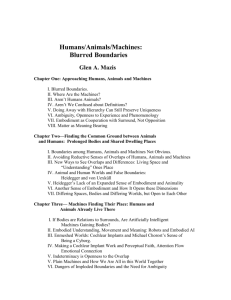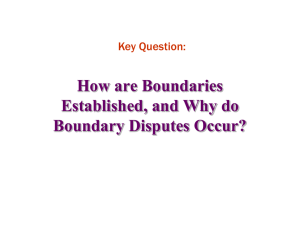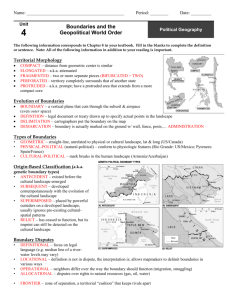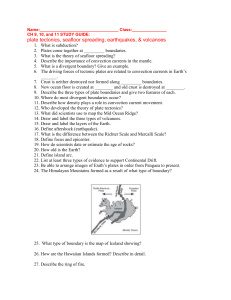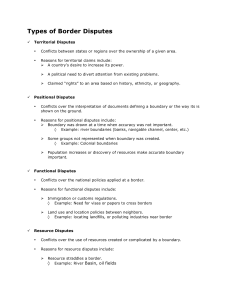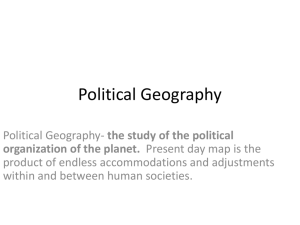Unit IV notes
advertisement
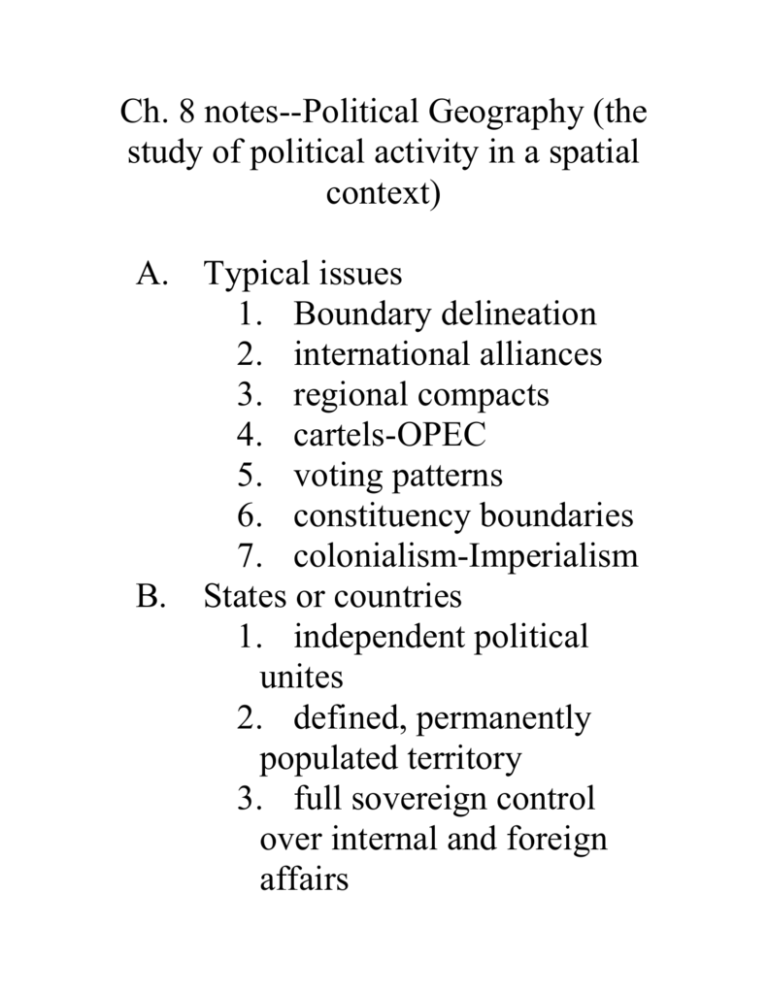
Ch. 8 notes--Political Geography (the study of political activity in a spatial context) A. Typical issues 1. Boundary delineation 2. international alliances 3. regional compacts 4. cartels-OPEC 5. voting patterns 6. constituency boundaries 7. colonialism-Imperialism B. States or countries 1. independent political unites 2. defined, permanently populated territory 3. full sovereign control over internal and foreign affairs 4. exceptions: colonies and protectorates C. nations 1. group of people with a common culture 2. a strong sense of unity 3. shared customs and beliefs 4. language and religion similarities D. stateless nations (Palestinians, Kurds) and nation-states (Japan, France) E. origins and diffusion of the modern state 1. European model (Greece, Rome, Normans) 2. Treaty of Westphalia (1648)-gave rise to the nation state 3. rise of nationalism— movement within a nation to maintain cultural identity (manifest destiny, white man’s burden, missionaries) 4. concept of sovereignty 5. political systems that emerged in Europe a. de jure sovereignty—treaty determined b. de facto sovereignty –natural occurrence 6. Colonialism --Imperialism— decolonization a. Imperialism( the drive toward the creation and expansion of a colonial empire and once established its perpetuation) b. Colonialism (rule by an autonomous power over a subordinate and alien people and place. Colonialism also creates unequal cultural and economic relations) c. Types of imperialism (economic, military, cultural) d. Types of colonialism (overland and over-seas) i. Land empires(14001700)-Spain setting up motherland political and economic systems ii. Sea empires(14001700)- Portugal, England, Dutch; small coastal empires for trade and resources-not much interior development iii. Settler empires (1400-1700)- settled vast lands without assimilation; Australia, New Zealand iv. Nationalist empires (18801991) “Africa” land grabbing motive; Berlin Conference— 1884-divides Africa among Europeans Powers; by 1991 most colonies are independent F. Geographic characteristics of states (size, shape, location and core areas) 1. territory morphology— size and shape of a country a. compact (Bangladesh, Switzerland, Iceland, Luxembourg, Belgium) b. fragmented (Philippines, Japan, Indonesia) c. elongated (Chile, Norway, Malawi) d. Protruded (Thailand, Myanmar) e. Perforated (San Marino, S. Africa) 2. Enclaves and exclaves (Transcaucasia, Hong Kong(enclave of China)— until 1997, Alaska is an exclave of the US, Oman has an exclave) 3. Landlocked (Bolivia, Nepal, Switzerland, Afghanistan) 4. land boundaries (include subsoil) 5. evolution of boundaries a. definition(legal document drawn up on exact location) b. delimitation (cartographers put boundaries on a map) c. demarcation (boundary is marked by posts, fences, wall, pillars) 6. types of boundaries a. geometric boundaries b. natural-political boundaries(rivers, lakes, seas) c. cultural-political boundaries(Azerbaija n-Armenia) 7. Genetic boundaries (Hartshorne) a. Antecedent boundaries (precede actual development through sparsely or uninhabited areas— tropical rainforests)ex. New Guinea b. Subsequent boundaries (drawn up after settlement has taken place) ex. Czech Rep., Slovakia c. Superimposed boundary (ignores existing cultural or tribal groupings) ex. Forcibly drawn by powers d. Relic boundary (ceases to function as a boundary anymore but is still present— The Great wall of china, Hadrian’s Wall) 8. Boundaries vs. Frontiers (zones of separation) 9. boundary disputes a. definitional boundary disputes (legal language of boundary agreement river may change course) b. location boundary disputes (delimitation or demarcation situations—treaty was vague or its somewhere in a desert—ex. Saudi Arabia, Yemen c. operational boundary disputes (one state wants to limit migration while the other does not-to prevent drug smuggling d. allocational boundary disputes (Iraq vs. Kuwait over oil reserves G. Political organization of states or countries 1. core states and multicore states (Nigeria) 2. capital cities and “forward capital” 3. unitary, confederate, and federal systems 4. Centripetal (promote national unity) vs. centrifugal forces(divisive forces) a. Nationalism b. Religion c. Infrastructure d. Common history e. Social inequality H. Geopolitics (the study of the state and its relationships to space—Considers economic, political, and military space) 1. Alfred Mahan’s Seapower Doctrine-acquire overseas bases—Hawaii, Guam 2. Ratzel’s Organic theory (environmental determinism – Nazi philosophy-“Space is the state’s essential, life giving force” 3. Mackinder’s Heartland theory (1904) British polit. Geographer –“whoever rules the heartland, rules the world” 4. Spykman’s Rimland Theory (1994) trading centers, ex. Suez, Bosporus 5. A Multipolar World( four potential superpowers—China, Europe, Russia, US) 6. Wallerstein’s World Systems Theory(states develop as capitalistic core countries and periphery countries) 7. A multipolar World Theory (4 or 5 superpowers—China, Europe, Russia, US 8. New super powers of the future (China—US) Russia in decline 9. Containment theory (cold war—NATO, SEATO) 10. Domino Theory (Vietnam War) I. Global Organizations and Multinationalism 1. Supranationalism (interstate cooperation— European Union, APEC, NATO) 2. United Nations a. Peacekeeping operations b. International sanctions c. Unrepresented Peoples(Basques, Tibetans, Tartars, Kurds) d. Laws of the Sea i. Territorial sea (certain number of miles offshore claimed by countries) ii. Truman Proclamation (US would regulate fisheries’ activities adjacent to its coastline and natural resources of the subsoil and seabed of the continental shelf contiguous to the coast would be subject to the jurisdiction and control of the US) iii. Widening Maritime Claims(Argentina, Peru, Chile claimed 200 miles of coastal waters in rich fishing areas in 1947) iv. National conference on the Law of the Seas (territorial sea— state sovereignty extends in all forms over 12 nautical miles; The exclusive Economic zone— states have economic rights up to 200 nautical miles from shore and rights to control exploration of natural resources in the water, seabed, and subsoil below) v. Median-Line Principle (if countries are not separated by a full 200 miles states divide the waters between the— North Sea, Baltic Sea, Med. Sea, Caribbean Sea) 3. Regional Multinational Unions a. Economic supranational (Benelux, common Market, European Community, EU, NAFTA, Assoc. of Caribbean States, APEC, Economic Community of West African states, OPEC) b. Military Alliances (NATO, SEATO, ANZUS) c. Cultural organizations and political unions (the Arab League, org. of African Unity, the French community, British Commonwealth) J. Choke points (strategic transit points throughout the world) 1. Eurasia—Gibraltar, Bosporus-Dardenelles, Bab el Mandeb, Strait of Malacca, strait of Hormuz, Suez Canal 2. W. Hemisphere—Strait of Magellan, Bering Strait, Panama Canal K. Devolutionary pressures in Europe 1. Balkanization—ethnic cleansing 2. Dayton Accords partition line—Bosnia 3. Devolution in Kosovo 4. Devolution in Russia (Dagestan, Chechenya) 5. Devolution in Africa (Nigeria, Sudan) 6. Devolution in Indonesia (Bali, E. Timor) L. Irredentism—cultural extension and potential expansion by a state or country aimed at a community of its nationals living in a neighboring state M. Electoral geography“gerrymandering”-drawing of voter district boundaries to benefit a particular group or political party-to dilute or pack a voting bloc N. The New World Order 1. Globalization—the expansion of econ., polit., and cultural activities 2. McDonaldization of the world 3. Chinese “Free Enterprise zones” 4. Hong Kong and Singapore—Laissez faire zones future? 5. Devolutionary results and effects in the former USSR 6. the “clash of civilizations theory”-Samual Huntington 7. the ‘Resource Wars Theory—Michael Klare

